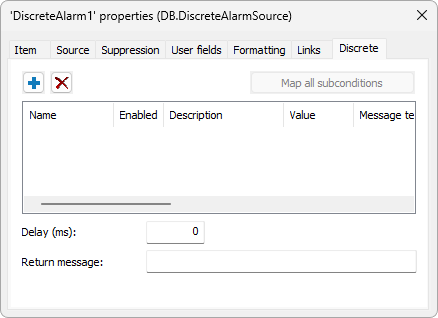Allows monitoring a variable by specifying multiple sub-conditions.

Discrete tab
The available options on this tab are described on the next table.
Available options for the Discrete tab
Option |
Description |
|---|---|
Create new subcondition |
Adds a new Sub-condition to this Alarm |
Delete selected subcondition |
Deletes the selected Sub-condition |
Map all subconditions |
Allows mapping and syncing Alarm Sub-conditions from Semantics available in the source object. This feature is currently supported only by Elipse Power and Elipse Water server objects, therefore this option remains disabled by default in Elipse E3 |
Name |
Sub-condition's name |
Enabled |
Enables or disables this Sub-condition |
Description |
Sub-condition's description |
Value |
A value evaluated to determine whether this Alarm occurs or not |
Message text |
Message displayed when this Sub-condition is active |
Type |
Sub-condition's behavior. Available options are 0: Alarm, 1: Event, or 2: Return |
Severity |
Sub-condition's severity type. Available options are -2: Critical, 0: High, 1: Medium, or 2: Low |
Need Ack? |
Indicates whether this Sub-condition needs acknowledgment or not |
Allow shelving? |
Enables or disables shelving this Alarm's Sub-condition |
Shelve maximum duration |
Maximum time, in minutes, this Alarm's Sub-condition can remain shelved. Default value of this option is 60, that is, one hour |
Maximum shelve count |
Maximum number of times this Alarm's Sub-condition can be shelved. Default value of this option is 0 (zero), that is, no limit |
Delay (ms) |
Specifies a delay time, in milliseconds. When this value is equal to 0 (zero, default), no delay is applied |
Return message |
Allows specifying a text displayed to users when this Alarm is not in an active condition |